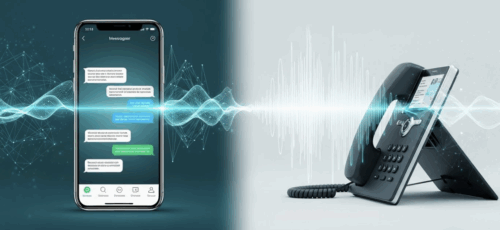Prioritizing the customer experience by making it smooth and convenient has become essential in the modern business landscape. According to McKinsey, digital natives like Netflix and Amazon have raised the bar in customer satisfaction with on-demand, tailored approaches to the customer experience.
Consumers demand flexibility and convenience when they work with a company, requiring a multifaceted approach to communication and seamless interactions. Inbound DIDs are an ideal way to ensure callers reach their intended recipient quickly without complex or frustrating processes.
As a developer, you can improve your business or client’s customer service with the convenience and speed that DID provides, leading to seamless customer experiences. DID is a service offered by enterprise-grade voice solutions that delivers reliability and a direct method of routing calls for customers and internal users.
It eliminates the need for live receptionists, operators, call trees, and extensions that can confuse callers and increase frustration. Understanding inbound DIDs, their benefits, and integrations can help you determine the ideal method to implement DID into your client or organization’s phone system.
What Are Inbound DIDs?
Direct inward dialing (DID) is a feature of modern Session Initiation Protocol (SIP) voice systems. It receives inbound calls and routes them directly to the intended recipient as specified by the company. DID simplifies communication by eliminating the need for extensions, operators, and interactive voice response (IVR) systems while delivering callers to their desired destination seamlessly.
DID technology is easy to incorporate with a variety of communication systems. Organizations can implement DID for traditional communication solutions using a private branch exchange (PBX). However, a cloud-based Voice over Internet Protocol (VoIP) or Session Initiation Protocol (SIP) trunking solution provides inbound DID virtually without the need for a costly PBX and traditional phone lines. It can also work with compatible existing PBX and virtual PBX systems. Since the DID is in the cloud, it offers fast configuration and near-limitless scalability.
How Does DID Work?
An organization using DID assigns a specific phone number to an extension. It allows callers to reach a number directly instead of calling an operator, using an IVR menu, or dialing a business phone number with an extension. Inbound DID calls are sent directly to the intended recipient. Each workstation or employee can have an individual phone number for customers and internal users to reach them conveniently. It can provide a better customer experience and reduce the number of missed calls.
How Can DID Benefit a Business?
Integrating and setting up your DID is simple when you partner with a reputable cloud-based SIP provider. You can easily procure new numbers or port over existing numbers from your management portal.
Customization allows you to select whether the DID will have texting capabilities or only VoIP, and you can choose from local, international, and toll-free numbers. If you are managing high volumes of phone numbers for a business or client, you can also use a phone number application programming interface (API) to streamline DID number assignment.
Related: Routing Inbound Calls Based on DID Numbers
DID offers the following benefits for businesses:
- DID can facilitate remote call forwarding, ensuring calls are routed to the correct recipient even when they are out of the office.
- DID provides a direct phone number for a user or workstation, allowing customers to reach their desired contact seamlessly.
- DID can provide customers with a fast and convenient method to reach the correct user or department, giving off a more professional impression.
- DID improves customer satisfaction, encouraging customers to work with the business.
- DID reduces time and resources spent on building an IVR or hiring a receptionist, allowing the business to redirect resources to more profitable operations.
How Do Businesses Use DID?
Along with a cloud-based VoIP or SIP calling solution, DID can enhance business communications. Organizations use DID in several implementations to:
- Improve the customer experience
- Reduce costs
- Increase mobility
- Enhance productivity
- Create seamless business continuity
Let’s take a look at each of these benefits in greater detail.
Eliminate Complex Extensions and IVRs
One of the primary reasons companies adopt DID for their phone systems is to eliminate complex IVR systems and extensions. Confusing extensions and hard-to-navigate IVR systems can frustrate callers seeking a fast solution.
Implementing DID into your client or company’s business phone can improve customer satisfaction, providing speed and convenience. According to a study in Forbes, consumers are looking for fast solutions when they call a business. They will pay nearly 20% more to receive immediate service when they choose a business to work with. Eliminating time-consuming and complex processes can help your client or business grow and retain customers.
When you combine DID with remote call forwarding, the organization won’t need to change extensions or IVR options when a worker is out of the office. The phone system can use remote call forwarding to dynamically route the call to the correct DID number outside the office, including the user’s mobile phone. As the developer, implementing DID means providing a simplified solution for your client or company without designing and testing an IVR system to ensure callers receive the care they expect.
Reduce Costs
If your client or business has not implemented an IVR or DID, they’re likely to use an operator or live receptionist to answer phone calls and transfer them to the appropriate destination. It can be costly to employ a live receptionist to answer phone calls, but implementing DID allows the business to save money and divert resources to more complex and profitable operations.
When an individual calls the business using a DID phone number, they can reach the intended recipient without speaking to a live receptionist or operator. Relying on DID rather than a receptionist means that the organization’s callers will consistently have a seamless interaction and experience. There’s no need to accommodate lunch breaks or make changes to after-hours callers.
Increase Productivity With DID
While DID helps callers outside the business reach the right recipient, it can also help internal callers reach other departments and points of contact, ensuring a smooth and productive communication experience for internal users.
Since DID is provided by a remote-friendly cloud-based calling solution, such as VoIP or SIP, it can enhance collaboration in a distributed workforce. Employees spread across a larger geographic region can easily call internal phone numbers without complex extensions.
Increase Business Continuity With Physical Failover
While DID can make the calling experience more convenient, it can also boost business continuity. When combined with a voice communication network with dynamic physical failover, DID can provide resilience and ensure business moves forward without a hitch. Inbound DID callers will be dynamically rerouted to a working physical network when there is an outage or interruption, guaranteeing callers get through unimpeded.
Related: What Is Remote Call Forwarding? How It Works and Best Practices for Effective Implementation
As mentioned earlier, you can combine DID with remote call forwarding, a feature that can bolster business continuity, allowing employees to answer the phone from a remote office environment. Implementing remote call forwarding with DID provides continuous operations when employees are working off-site due to construction, power failures, natural disasters, or other out-of-the-ordinary situations.
Create Seamless Mobility and Portability
DID’s ability to facilitate remote office arrangements can be a solution for business continuity and can also assist organizations that want to offer remote work opportunities to employees. Flexible work environments have become increasingly popular, but providing voice communication and collaboration can be challenging with traditional onsite phone systems.
A cloud-based voice solution with DID provides seamless communication from anywhere with a stable internet connection. Authorized users can log in to the VoIP or SIP solution from a software-based phone, IP phone, or mobile device from any location and ensure inbound DID callers reach their intended recipient.
How Can You Implement DID for Your Business or Client?
Harnessing the benefits of DID for your client or business begins with finding a cloud-based voice communication platform. Whether you are implementing VoIP or voice SIP trunking for the organization, you can integrate DID when you choose a reputable partner that offers this business-enhancing feature. While DID was implemented with PBX in the past, cloud-based solutions can incorporate DID without the need for costly onsite hardware.
When selecting a cloud-based voice partner, ensure they offer DID with physical failover and remote call forwarding to get the resiliency benefits. A voice provider that offers scalability and flexibility is also critical to getting optimal value from VoIP or SIP with DID. Implementing DID with a cloud-based voice service can be simplified using a programmable voice and a phone number API.
Programmable APIs for phone calling are typically written in representational state transfer (REST) architecture. REST APIs are resource friendly and stateless. They don’t store client information in the server but do offer a range of compatibility to make implementation in your preferred coding language simple. You can implement your client or company’s voice service into its systems and software using an API, reducing hours of development and testing to a couple of lines of code.
A phone number API is essential to managing DID phone numbers. It allows you to port existing business phone numbers from a traditional carrier to the new cloud-based solution and procure new toll-free, vanity, and local phone numbers for use with DID. Selecting a voice service platform that offers APIs and documentation to facilitate integration and configuration will ensure you can deliver a reliable solution to your client or business.
Is Your Company or Client Ready to Implement DID?
Implementing DID with a cloud-based voice solution can enhance your company or client’s communications and provide seamless customer interactions. As more businesses switch from IVR integrations and extensions, DID provides a solution to reducing costs, call times, and complexity of phone systems. Selecting a scalable and reliable solution with an API for simple implementation of DID calling is critical to optimizing the value of your client or company’s new solution.
Flowroute is a cloud-based communications provider delivering resiliency and scalability to your business or client with the HyperNetwork™. Using the programmable voice API and numbers API, you can seamlessly implement a calling solution with inbound DID for your client or company. We offer the scalability of the cloud, 24/7 availability, and uptimes of 99.999% to guarantee delivery of inbound voice calls. Get started with a resilient voice solution for mission-critical communications applications from Flowroute.






